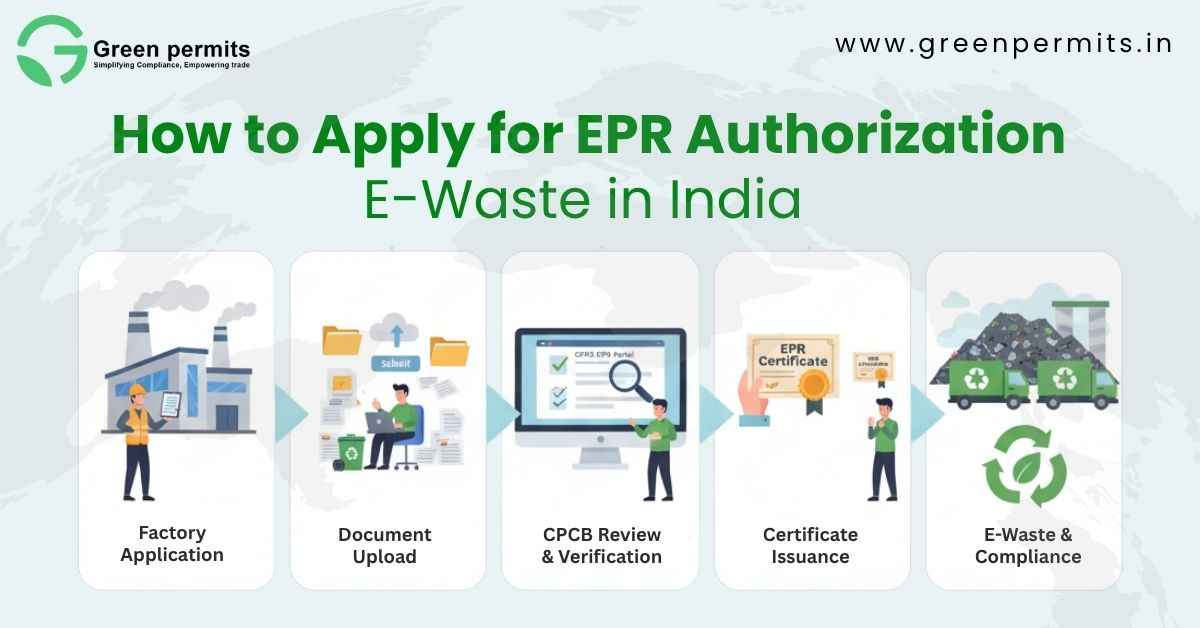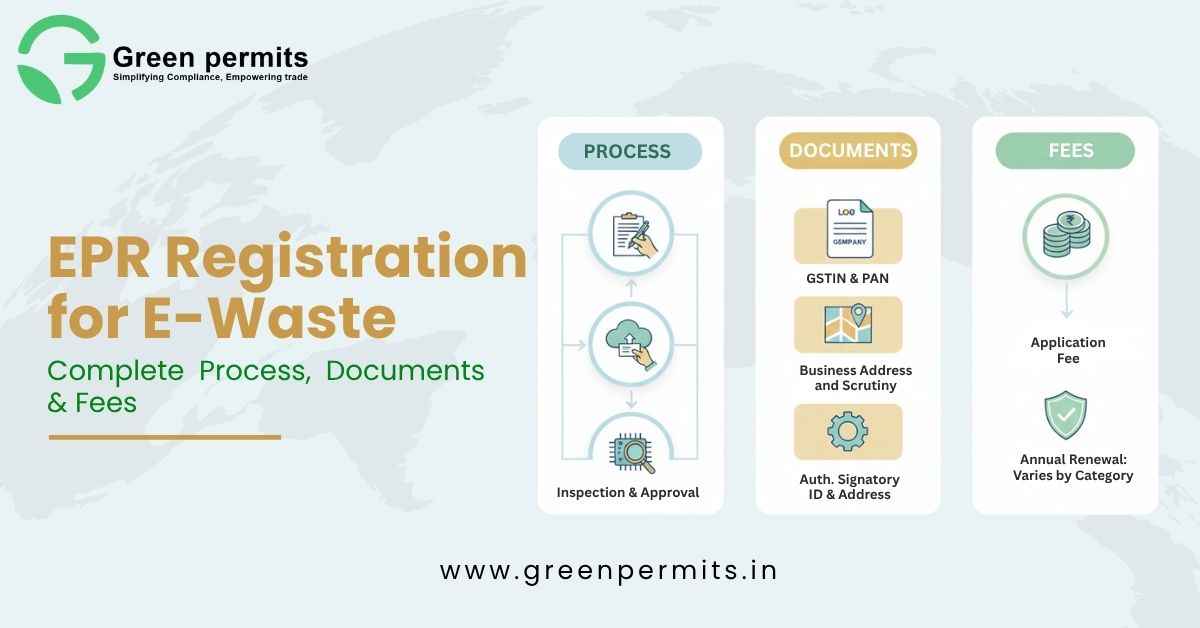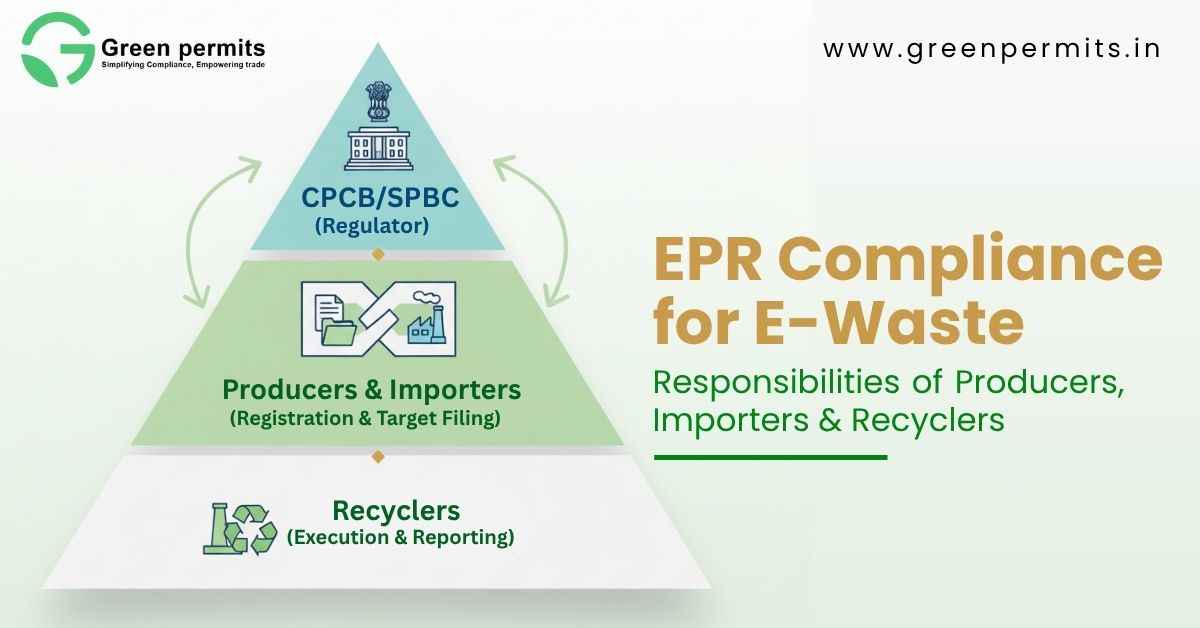When TechNova Systems Pvt. Ltd., a growing electronics manufacturer from Pune, prepared to launch its new smart device range, everything seemed on track—until their shipments got stuck at customs.
The reason? Missing EPR authorization under India’s latest E-Waste (Management) Rules, 2022.
What followed was weeks of confusion, document requests, and frantic calls to the Central Pollution Control Board (CPCB).
TechNova’s story isn’t unique. Many Indian manufacturers and importers still find EPR registration complex, even though it’s now mandatory for all electronics-related businesses.
This guide simplifies the process into clear, actionable steps, helping you understand exactly how to apply for EPR authorization for e-waste in India in 2025.
Understanding EPR Authorization and Why It Matters
Extended Producer Responsibility (EPR) is not just a regulatory formality—it’s a sustainability commitment. It ensures that the companies placing electrical and electronic products into the market take accountability for how those products are managed once they become waste.
Under E-Waste (Management) Rules, 2022, all entities involved in manufacturing, importing, refurbishing, or recycling electronic goods are legally obligated to register with the Central Pollution Control Board (CPCB).
Without this authorization, businesses cannot legally manufacture, import, or sell electronic equipment in India. It’s the foundation of India’s circular economy approach, where waste materials are reintroduced into the production cycle through responsible recycling and reuse.
Who Needs EPR Authorization for E-Waste?
If your company deals with electronic or electrical products at any stage of their lifecycle, you likely need EPR authorization. The CPCB portal identifies four major categories:
- Producers – Entities that sell or import electrical and electronic equipment under their brand.
- Manufacturers – Units that produce or assemble electrical and electronic equipment or components.
- Recyclers – Businesses engaged in processing or recovering valuable materials from e-waste.
- Refurbishers – Units that repair, rebuild, or recondition used electronics for resale or reuse.
Each type of entity must apply for registration separately on the EPR e-waste portal (eprewastecpcb.in). Operating without registration can result in penalties, suspension, or prosecution under the Environment (Protection) Act, 1986.
Step-by-Step Process to Get EPR Authorization in 2025
Step 1: Determine Your Business Category
Before applying, identify which type of authorization applies to your operations.
A company manufacturing and importing electronics (like TechNova Systems) must apply separately as both Producer and Manufacturer.
This distinction ensures each activity—production, import, or recycling—is traceable in the CPCB portal.
Step 2: Create an Account on the CPCB E-Waste Portal
Visit https://eprewastecpcb.in and click on Sign Up.
During registration, provide:
- Company name and registered address
- GST, PAN, and CIN or IEC (for importers)
- Authorized person’s name, designation, mobile number, and email ID
- A valid OTP sent to both mobile and email
Your credentials will allow access to the CPCB portal dashboard where all filings and communication take place digitally.
Make sure the authorized person’s email and phone number are active—CPCB will only communicate through them.
Step 3: Complete the Online Application
Once your login is created, the system will prompt you to fill the relevant form depending on your category.
Here’s what each applicant needs to upload:
| Entity Type | Documents Required |
|---|---|
| Producer | GST Certificate, PAN, IEC (for importers), CIN, Self-declaration on RoHS compliance, CA-certified sales data, and a detailed awareness plan. |
| Manufacturer | Valid CTE and CTO from SPCB, Authorization under Hazardous Waste Rules, GST and PAN, IEC (if applicable), and details of plant layout and production capacity. |
| Recycler | Valid CTE and CTO, Hazardous Waste Authorization, Geo-tagged video and photographs of plant machinery, recycling flow diagram, and list of recovered materials. |
| Refurbisher | CTE and CTO, PAN and GST, Geo-tagged video of the facility, capacity details, and a self-declaration for safety measures. |
Ensure every uploaded document has the same registered address as mentioned in GST and consent orders. Mismatched addresses are the most common cause of application rejections.
Step 4: Upload Self-Declarations and Safety Confirmation
Each applicant must submit a self-declaration letter on company letterhead confirming that:
- All details and data provided in the portal are accurate.
- The facility adheres to occupational health, safety, and fire protection norms.
- No unregistered partners or subcontractors are engaged in e-waste operations.
This declaration must be digitally signed and uploaded in PDF format. Many applicants also attach supporting documents such as internal safety audit reports or staff training certificates.
Step 5: CPCB Review and Digital Checklist
After submission, CPCB officers review your application within 30 working days.
If any documents or information are missing, you’ll receive a digital checklist through the portal listing all deficiencies.
You’ll have 7 working days to respond and upload clarifications.
Once verified, your file moves to the Divisional Head (Waste Management Division–III) at CPCB for final approval.
In practice, well-prepared applications often get processed faster—within 15 to 20 days—especially when digital documents and videos are complete.
Step 6: Grant of Registration and Validity
Once approved, CPCB issues a digital EPR Registration Certificate that includes your unique registration number and a list of authorized activities.
- Validity: Five (5) years from the date of approval
- Inspection: CPCB or SPCB officials may conduct physical or virtual inspections within 90 days to confirm operational compliance.
If discrepancies are found, the registration can be suspended or revoked after due notice.
Renewals must be filed 120 days before expiry to avoid delays.
Official Fee Structure for EPR Authorization (2025)
| Category | New Registration (₹) | Renewal (₹) | Amendment (₹) | Annual Maintenance (₹) |
|---|---|---|---|---|
| Recycler | 15,000 | 7,500 + 0.625/MT (for EPR certificate transactions) | 3,000 | 5,000 |
| Refurbisher | 15,000 | 7,500 + 0.625/MT | 3,000 | 5,000 |
| Manufacturer | 15,000 | — | 3,000 | 5,000 |
| Producer | 2,500 – 15,00,000 (based on annual recycling target) | — | 10,000 | 5,000 |
All payments are made directly through the CPCB portal via the secure online gateway.
Compliance Timelines at a Glance
| Activity | Timeline |
|---|---|
| CPCB review of new application | 30 working days |
| Correction or deficiency response | 7 working days |
| Registration validity period | 5 years |
| Facility verification by CPCB/SPCB | Within 3 months of approval |
These timelines ensure transparency and predictability for businesses preparing compliance documentation.
Why Early EPR Registration Benefits Your Business
Getting registered early isn’t just about avoiding penalties—it’s a strategic move that offers measurable advantages:
- Smooth trade operations – Customs clearance, imports, and exports move faster when CPCB registration is verified.
- Corporate credibility – Buyers and OEMs prefer dealing with registered, compliant partners.
- Sustainability edge – EPR compliance demonstrates environmental responsibility, which can attract ESG-focused investors.
- Avoid penalties and delays – Non-registration can lead to suspension of business activities or loss of tenders in public projects.
For startups or importers, early registration often saves weeks of administrative bottlenecks.
Case Example: How TechNova Systems Simplified EPR Filing
TechNova initially attempted to file their registration independently but faced multiple rejections due to mismatched CTE and GST addresses. After partnering with a compliance consultant, they updated their plant documents, created geo-tagged videos, and re-applied with accurate details.
Within 18 working days, they received their CPCB authorization.
This proactive approach not only prevented further shipment delays but also qualified them to sell under major retail contracts requiring verified EPR numbers.
Consequences of Non-Compliance
Operating without CPCB registration can result in:
- Suspension of manufacturing or import activities
- Revocation of business licenses
- Fines and prosecution under the Environment (Protection) Act, 1986
- Inability to issue or redeem EPR certificates for recycling obligations
For small manufacturers, even a temporary suspension can disrupt supply chains and client relationships.
Conclusion: Compliance as a Competitive Advantage
EPR authorization has transformed from a regulatory formality into a business necessity. Whether you’re a startup importer or an established electronics manufacturer, aligning with the CPCB’s E-Waste framework ensures smoother operations, improved credibility, and contribution to India’s sustainability goals.
By following the six-step process detailed above, companies can easily navigate the EPR system and remain fully compliant in 2025 and beyond.
Call to Action
📞 Need expert help filing your EPR Authorization with CPCB?
Green Permits Consulting assists Indian manufacturers, importers, and recyclers with complete compliance—documentation, filing, inspection coordination, and renewal support.
📧 wecare@greenpermits.in | ☎ +91 78350 06182
Book a Consultation with Green Permits
Book a Technical Call with Expert
FAQs
It’s valid for five years from the date of issue and can be renewed online before expiry.
Yes. For example, a producer who also recycles waste must apply separately for both roles.
Updated CTE/CTO, annual returns, and any revised production or recycling data.
Usually within 30 working days, provided all documents are accurate and complete.
Yes. CPCB or the respective State Pollution Control Board conducts a physical or virtual inspection within three months of registration.



